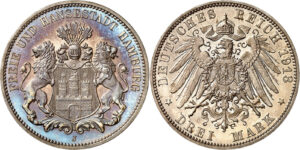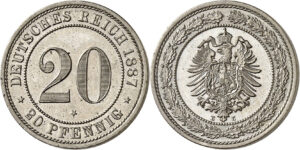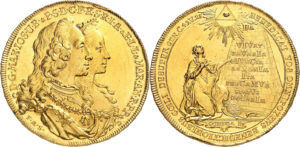High-Quality Coins of the German Empire at Grün
If you are looking for perfect coins in uncirculated, proof or first strikes, you should carefully study auction 82 of Heidelberger Münzhandlung because Herbert Grün offers an exceptional collection. Known for their precise and conservative coin descriptions, the auction house, which is specialised in German coinage, offers a collection that even a connoisseur like Herbert Grün has not encountered frequently over the course of his life as a dealer. Whether they are common ore rare, the collector insisted on including only the best of the best in his collection. Coins that are less than “extremely fine” are rarely to be found, most pieces are better than “extremely fine”.
But this outstanding collection should not distract from the fact that auction 81 is also worth a close look. After all, the auction comprises about 800 lots with German coins minted after 1871. In addition, there are world coins from antiquity to modern times as well as paper money, among all of them numerous rarities.
Due to the current situation regarding Covid-19, Heidelberger Münzhandlung opted not to hold a public auction. Instead, live bidding will be possible. Those who prefer the traditional ways of bidding can obviously submit bids via letter, email or phone. Viewing the lots is possible depending on the applicable regulations.

Auction 82: Special Collection of German Coins After 1871
On 12 May 2021 at 9.30 a.m. auction 82 starts as an exclusively live bidding event at the premises of Heidelberger Münzhandlung. Bidders will not be allowed to attend the sale of the 1,150 lots featuring German coins minted after 1871 in person, however, they can submit their bids via phone or by means of their computer.
The special collection offered by Herbert Grün in his auction 82 stands out because of the incredible quality of the coins it contains. We present a few examples in this preview.
The first lot we will show you is an extremely rare 1 mark piece from 1879. In order to understand how rare this former circulation coin is, you must be familiar with its background: Nine mints – if you count Muldenhütten and Dresden as a single Saxon mint – produced coins of smaller denomination during the era of the German Empire. Usually, the mintage figures of the important and frequently used 1 mark pieces amounted to several million specimens. In 1875, for instance, the nine mints produced a total of almost 75 million specimens, and in 1876 another 35 million pieces. This satisfied the demand for the time being. Therefore, only 745,526 pieces of this denomination were minted in 1877. The special collection contains as much as two specimens of this rarity, one of them in Proof quality.
But the 1 mark piece of 1879 is even rarer. In that year, only Berlin minted this denomination, and they produced as few as 156,444 pieces. Keep in mind that these are circulation coins. Thus, it is almost a miracle that Grün is able to offer such a rare coin in Proof quality.

With a mintage of only 45,493 pieces, the 2 marks piece from Baden of 1883 is considered one of the rarest 2 marks pieces of the German Empire, especially in the outstanding quality offered by Herbert Grün. FDC combined with a beautiful patina make this coin a showpiece of the highest rarity.
Those who know Herbert Grün are aware of the fact that if he describes a specimen as a showpiece, it truly is one. After all, the long-established auction house Heidelberger Münzhandlung is famous among German collectors for giving extremely conservative coin descriptions and for indicating every flaw in detail. In other words: if Heidelberger Münzhandlung describes an item as FDC, Proof or first strike, the piece has great potential to obtain an excellent grade according to the Sheldon Scale, which is widely used throughout the world.
Please find here a legally non-binding comparision between the Sheldon Scale and the descriptions of Heidelberger Münzhandlung.
First strike = MS/PF 69-70
FDC = MS/PF 65-68
almost FDC = MS/PF 60-65
Minor scratches and a beautiful patina are indicated by Grün in detail.

Due to the silver shortage during the First World War, Bavaria was only able to mint about 130 pieces of the coin known among collectors as the “Bayernhochzeit” (Bavarian Wedding) on the occasion of the golden wedding anniversary of its royal couple. The special collection contains one of the most beautiful specimens Herbert Grün has seen in the past decades.

If you are enthusiastic about coins of outstanding quality, you do not have to spend six-digit sums. The estimates start at 10 euros. Numerous perfect issues such as this specimen from the Hanseatic City of Hamburg with a wonderful rainbow patina have estimates in the lower three-digit range, even though it is obviously unclear whether they will actually be sold for that amount.

With as few as 100 issued specimens, this 2 marks piece minted in Berlin is one of the rarest coins of the German Empire. By the way, the indication in Jaeger’s work that the piece was minted on the occasion of the christening of the hereditary prince is probably a myth that has never been verified. After all, the “hereditary prince” Johann Leopold had already been baptised in the presence of emperor William II in 1906. The couple’s daughters were born in 1908, 1909 and 1912. The last descendant, Frederick Josias, who became head of the House of Saxe-Coburg and Gotha in 1954 after his brother married a woman who was considered improper for his rank, was born as late as in 1918.

Although the focus is on coins of the German Empire, the exceptional collection covers the entire period from the beginning of the Empire’s coinage in 1871 to the era of Allied-occupied Germany between 1945 and 1948. As an example, we present the last 5 reichsmarks piece of the Weimar Republic, which was issued at the low mintage of 422,800 pieces, although this figure only refers to the coins minted in that year. Many of them were probably minted with old dies featuring the year 1932.
To see this rarity in Proof quality is a feast for the eyes.
All collectors of German coins after 1871 are strongly encouraged to also take a look at auction catalogue 81 of Heidelberger Münzhandlung. It contains another 804 lots of this field of collection, including many rarities.

Coins Minted After 1871 from Auction 81
We limit this preview to three great treasures.
Let’s start with a Saxon rarity. In 1887, the mint was moved from Dresden to Muldenhütten. In order to distinguish the first coins that were produced by the new mint, the mint master had the first 50 pieces adorned with a star underneath the face value. One of these pieces, which were already sold exclusively to collectors at that time, can be found in auction 81, a first strike that never entered circulation.

202,108 specimens of the 2 marks piece of Hesse of 1876 were issued. A few of them issued in Proof quality have survived. One of them can be found in auction 81.

The gold coins minted at the Berlin mint for the colony of German New Guinea are among the most popular German coins. 1,500 specimens were struck. They were far too sought-after by collectors to ever enter circulation. And that’s no surprise: Otto Schultz created one of the most beautiful modern coin designs with his two birds-of-paradise. We should mention that this image is also interesting in terms of monetary history. In fact, Schultz incorporated the most important currency of New Guinea into his design: bird pelts.

Auction 81: World Coins
The coins of the German Empire in auction 81 will be sold on Tuesday afternoon, 11 May 2021 between 1:30 pm and 7 pm. The actual auction 81 already starts on Monday, 10 May at 9.30 am
Auction catalogue 81 of Heidelberger Münzhandlung contains everything a collector could wish for, from antiquity to present day, coins, medals and paper money, German and World coins, and always issues for every budget.

Antiquity
More than 600 lots of ancient coins. Celts, Greeks, Romans, Byzantines, rarities such as a solidus of Constantinus III and common pieces at low estimates, moreover multiple lots, gold, silver and bronze issues, a series of tetradrachms from the city of Athens and another series of Alexandrian billion tetradrachms, this and much more, that’s what auction 81 begins with.

World Coins
Next are about 300 lots with world coins and medals, among them great rarities such as an almost extremely fine pfennig or denarius of Charlemagne from Limoges, which is an usually great quality for such a great rarity.
If you look closely, you will find a wealth of very rare coins of exceptional quality, for instance half talers and talers from 1590 commemorating the “Stückschießen” in Strasbourg. The obverse features the detailed image of a cannon, which was a key element of the regular military exercises. These manoeuvres were celebrated as municipal festivities and prizes were awarded to the best teams. In this way, the (Protestant) civic militia of Strasbourg demonstrated in the confessional age that they were prepared for a (Catholic) attack.

As I said, studying this catalogue is worth it regardless of your budget. Many rarities are waiting to be discovered, whether it be a ducat of King Ferdinand II of Aragon (1479-1516) minted in Perpignan, a 10 ducat piece of Czechoslovakia minted in Kremnica in 1931, a 1705 ducat by Francis Rákóczi. There are remarkable pieces from almost every field of collection.

Holy Roman Empire / Austria
The Habsburgs, for example, are represented by more than 160 lots, including numerous rare talers. The focus is on issues by Emperor Franz Joseph I. The catalogue does not only contain rare circulation coins but also the rarest among the first Austrian commemorative coins: “Vollendung der Südbahn”, “Raxalpe” and “Kuttenberg”.

German States
As always, Heidelberger Münzhandlung is able to offer a wealth of rare coins from the German States. There are about 50 lots from Bavaria, covering the period from Albert V (1550-1579) to Ludwig III, the last Wittelsbach on the Bavarian throne.

A rare historical testimony is one of only three known konventionstalers minted by Johann Maria Rudolph, Count Waldbott von Bassenheim as Burgrave of Friedberg. This nephew of the Archbishop of Mainz was something like the highest judge of in the Holy Roman Empire at the time of the wars against Napoleon. He was one of the two presidents of the Reichskammergericht in Wetzlar.

About 30 lots from the Palatinate will be offered in auction 81, including the oldest German river gold issue, a half ducat made of Rhine river gold, which was minted in 1674 in Heidelberg.

There would be even more to mention here: A very rare taler of the County of Henneberg minted in 1559 in Schleusingen, a 1568 gold gulden of Lüneburg of which only two specimens are known, a gold pattern for the Prussian taler of 1799, a taler commemorating the death of Frederick William II of Saxe-Altenburg in 1669 minted in Saalfeld, a taler klippe commemorating the shooting festival taking place on the occasion of the 35th anniversary of Duke Frederick II of Saxe-Gotha-Altenburg and a collection of more than 2,800 casino tokens of various national and international casinos.

Paper Money
We would like to point out that Heidelberger Münzhandlung is once again offering a remarkable range of 120 lots with paper money. Among them is an extensive series of military payment certificates of the armed forces of the USA as well as a collection of German banknotes from 1948.
Both auction catalogues can be purchased for the nominal fee of 12.50 euros at Heidelberger Münzhandlung Herbert Grün, Gaisbergstr. 40, 69115 Heidelberg, Germany; phone: +49 / 6221 / 65 2970; fax: +49 / 6221 / 65 297-29; email or at the website.
You will also find the catalogue on the auction house’s website as well as on Sixbid (Auction 81 and Auction 82), biddr.com (Auction 81 and Auction 82), and Numisbids (Auction 81 and Auction 82).




